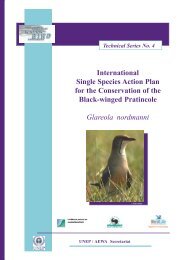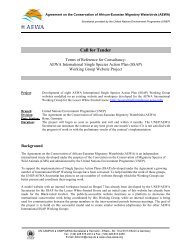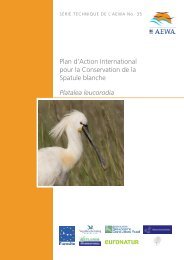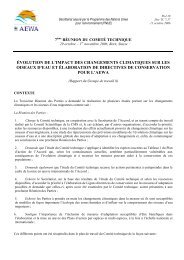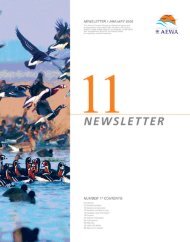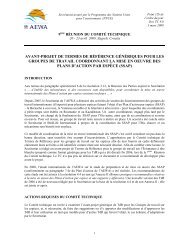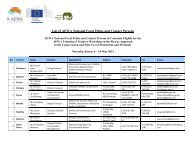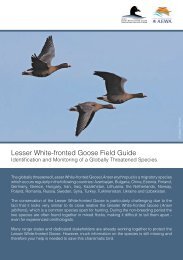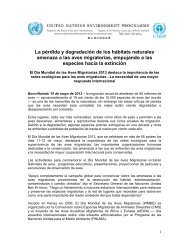International Single Species Action Plan for the ... - AEWA
International Single Species Action Plan for the ... - AEWA
International Single Species Action Plan for the ... - AEWA
Create successful ePaper yourself
Turn your PDF publications into a flip-book with our unique Google optimized e-Paper software.
<strong>AEWA</strong> Technical Series No. 36<br />
This <strong>Action</strong> <strong>Plan</strong> deals with conservation of two of <strong>the</strong> three wild populations – namely <strong>the</strong><br />
Fennoscandian population and Western main population. Given that <strong>the</strong> Eastern main<br />
population does not occur within <strong>the</strong> <strong>AEWA</strong> Agreement Area or <strong>the</strong> territory of Member<br />
States of <strong>the</strong> European Union, it is only mentioned when a global context or comparison is<br />
required. The <strong>Action</strong> <strong>Plan</strong> also takes into account a fourth population, derived from captivebred<br />
birds and used <strong>for</strong> restocking in Swedish Lapland (<strong>for</strong> population descriptions see<br />
chapter 1.3).<br />
1.3 Population Development<br />
Global population trend<br />
The global population of Lesser White-fronted Goose has declined rapidly since <strong>the</strong> middle of<br />
<strong>the</strong> 20 th century. The decrease in numbers has been accompanied by fragmentation of <strong>the</strong><br />
breeding range and is continuing to affect all populations, giving rise to fears that <strong>the</strong> species<br />
will go extinct unless <strong>the</strong> downward trend is halted and reversed. Overhunting and habitat loss<br />
are considered to be <strong>the</strong> main threats (e.g. Madsen 1996; UNEP/WCMC 2003; Fox 2005).<br />
These and o<strong>the</strong>r threats are described in detail in section 3.3. The global population decline is<br />
ongoing; BirdLife <strong>International</strong> estimates a decrease in numbers in <strong>the</strong> range of 30% to 49%<br />
during <strong>the</strong> period 1998–2008.<br />
Global population estimate<br />
The most recent estimate of <strong>the</strong> global mid-winter population is 28,000 to 33,000 individuals,<br />
derived from combining estimates <strong>for</strong> <strong>the</strong> two western populations (Fennoscandian and<br />
Western main) = 8,000 to 13,000 individuals, and <strong>the</strong> Eastern main population = 20,000<br />
individuals (Delany et al. 2008, Delany & Scott 2006). This compares with previous<br />
published global estimates of 25,000 to 30,000 individuals (Lorentsen et al. 1999) and 22,000<br />
to 27,000 (Delany & Scott 2002). The estimate <strong>for</strong> <strong>the</strong> Western main population is based on<br />
autumn surveys in <strong>the</strong> staging area in Kustanay region, north-west Kazakhstan (Tolvanen &<br />
Pynnönen 1998, Tolvanen & al. 2000). The estimate <strong>for</strong> <strong>the</strong> Eastern main population (14,000)<br />
published in Delany & Scott (2002) was an underestimate, because at <strong>the</strong> most important<br />
wintering site (East Dongting Lake nature reserve) alone, up to 16,600 individuals were<br />
counted in 2004 (Barter 2005). In spite of an increased population estimate owing to<br />
improving knowledge, both Eastern and Western main populations are considered to be<br />
declining (Delany & Scott 2006).<br />
The crash in numbers and contraction in range of <strong>the</strong> Fennoscandian population is well<br />
documented (see below), but less detailed in<strong>for</strong>mation is available <strong>for</strong> ei<strong>the</strong>r <strong>the</strong> Western main<br />
or Eastern main populations, which breed in Russia.<br />
Western main population<br />
The known breeding areas are indicated in Figure 1. The most recent population estimate <strong>for</strong><br />
<strong>the</strong> European tundra is 500 to 800 birds. Decreasing numbers and a contracting distribution<br />
have been noted within study areas in this region, even though no significant changes/impacts<br />
have been observed on <strong>the</strong> breeding grounds (Morozov & Syroechkovskiy, 2002). However<br />
<strong>the</strong>re is a fundamental lack of baseline in<strong>for</strong>mation; <strong>for</strong> example, Syroechkovskiy et al. (2005)<br />
underline <strong>the</strong> fact that <strong>the</strong> breeding grounds of some 8,000 birds of <strong>the</strong> subpopulation have yet<br />
to be located.<br />
Fennoscandian population<br />
The wild Fennoscandian population in <strong>the</strong> Nordic countries (i.e. excluding <strong>the</strong> unknown<br />
number of birds nesting in <strong>the</strong> Kola Peninsula of westernmost Russia – see below) was<br />
estimated in 2004 at only 20-30 breeding pairs and <strong>the</strong>re has been a sustained, statistically<br />
<strong>International</strong> <strong>Single</strong> <strong>Species</strong> <strong>Action</strong> <strong>Plan</strong> <strong>for</strong> <strong>the</strong> Conservation of <strong>the</strong> Lesser White-fronted Goose 11



